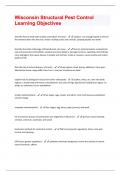Wisconsin Structural Pest Control
Learning Objectives
describe how to treat both outdoor and indoor ant nests - outdoor: use enough liquids to drench
the material down into the nest. indoor: dusting cracks and crevices, spraying liquids also works
describe the kinds of damage arthropod pests can cause - feed on stored products; contaminate
raw and processed commodities; weaken structural timbers; damage furniture, carpeting, and clothing;
carry pathogens that cause disease in people and animals; create a nuisance; cause anxiety and reduce
quality of life
Describe the structural features of insects - three regions: head, thorax, abdomen. three pairs
attached to thorax. wings differ from 0 to 2. one pair of antenna on head
explain how to distinguish insects from other arthropods - spiders, mites, etc. have two body
regions: a fused head and thorax, and abdomen; four pairs of legs attached to head/thorax region; no
wings; no antennae; has an exoskeleton
simple metamorphosis - three stages: egg, nymph, and adult. must molt because exoskeleton
cannot enlarge
complete metamorphosis - four stages: egg, larva, pupa (cocoon), and adult
list of common species of cockroaches you might find in Wisconsin - german, brown-banded,
oriental , american, australian, and wood
treatment methods for cockroach control - IGR (insect growth regulators), baits, crack-and-
crevice, and spraying
IGR (insect growth regulators) - synthetic chemicals designed to mimic the activity of natural
insect hormones. affects
,list the ant species - carpenter, larger yellow or citronella, thief or grease, pavement, cornfield,
and pharoah
list the ant species for which baits do or do not provide effective control - pharaoh, thief, worker,
and fire ants
describe how you would make an effective perimeter treatment for ants - spray under sliding door
frames, cracks and crevices. seal door frames
carpenter ant control - find the main nesting colony and kill the queen. use perimeter treatment
to keep the ants outside
specify where to concentrate flea control efforts in the animal's environment - eat and sleep
areas, wash animal. focus on where the pet spends most of its time, vacuum and cleaning up their area.
check chimneys, attics, and crawl spaces if no animal is a pet
list the advantages of IGRs and describe how they fit into a flea management program - IGRs
prevent fleas from developing and hatching, they also have low human and animal toxicity
describe the limitations of aerosols, flea "bombs," ultrasonic devices, and flea traps - these
materials can cause explosions or fires if access fumes build up in enclosed areas, they won't penetrate
through furniture or other items
outline the key to effective control of flies and food pests - find and eliminate food source, short
term bomb
describe the options for controlling powder post beetle infestations - surface-treat the infested
wood with pesticide. spray or paint borates onto exposed surfaces
describe what can make perimeter treatments for occasional invaders especially effective and why some
treatments fail - treating cracks and openings around windows, plumbing, doors, spaces between
, the foundation and siding are effective. Some treatments may fail because some insects might have
gotten past the perimeter treatment before you applied it
describe the life cycle of bed bugs and the importance of proper inspection - individual bed bugs
can lay 200 to 250 eggs in her lifetime. The eggs hatch in about 6 to 10 days. Adults live for about 2 to 4
months. If you don't properly inspect for bed bugs, then the infestation will not be controlled
describe some control methods for bed bugs including limitations of chemical control -
temperature below freezing or heat treatments. non-repellant products are primarily used
list physical differences between the Norway rat - weighs 7-17 ounces, 12-18 inches long, tail is 5-
8 inches, ears are close set, short, thick with short fine hairs, hind foot over an inch, 12 teats on female,
grayish belly fur
physical differences of the house mouse - weighs 0.5-1 ounce, 5-8 inches long, tail is 2-4 inches,
ears are large relative to head with some hairs, hind foot is under 3/4 inch, 10 teats on females,
brownish belly fur
distinguish the physical differences of a deer or white-footed mice - weighs 0.4-1.25 ounces, 5-8.5
inches long, tail is 2-4 inches, ears are equal to body length and sharply bi-colored: darker above, paler
below, larger ears and eyes than house mouse, females have 6 teats, whitish belly fur, white feet
explain how rodent signs can provide clues to the species, size, and vitality of a rodent population -
droppings can show you what kind of rodent it is, marks along the wall can help identify the
relative size of populations and activity level, tracks can help identify the species of rodents present,
burrows can show recent activity, and gnawing marks can also help identify the species
outline the range and limitations of rodents' senses and how they can influence management practices -
rodents have an acute sense of smell, rodents have highly developed taste, because they are
nocturnal their sense of touch is important, rodents have good hearing and react to sound, rodents are
very sensitive to light and have poor vision
describe some of the physical abilities of rodents - walk horizontal wires and pipes, climb vines,
shrubs, trees, brick, or other rough exterior walls, climb inside vertical pipes with inside diameter, climb




